Remotely addressable magnetic composite micropumps†
Eric
Diller
,
Shuhei
Miyashita
and
Metin
Sitti
*
5000 Forbes Ave., 320 Scaife Hall, Pittsburgh, PA 15213, USA. E-mail: sitti@cmu.edu; Fax: +1 412 268 3348; Tel: +1 412 268 3632
First published on 15th February 2012
Abstract
Remotely and selectively turning on and off the magnetization of many micro-scale magnetic actuators could be a great enabling feature in fields such as microrobotics and microfluidics. We present an array of addressable 800 × 800 × 75 μm3 micropumps made from a composite material whose net magnetic moment can be selectively turned on or off by application of a large magnetic field pulse. The material is made from a mixture of micron-scale neodymium-iron-boron and ferrite particles, and can be formed into arbitrary actuator shapes using a simple molding procedure. By selectively controlling the orientation of each of an array of micro-actuators prior to the application of the field pulse, the magnetic on/off state of each can be controlled independently. The micropumps are actuated by rotating magnetic fields up to 12 kA m−1 in strength to pump liquid through 100 μm fluid channels. A distinct transition between the on and off states is seen by application of pulsed magnetic fields of about 240 kA m−1 in strength. As a demonstration, we show addressable on/off control of two micropumps and five simple spinning magnetic microactuators, with potential applications for lab-on-a-chip type fluidic devices.
1 Introduction
Recent works in micro-scale magnetic actuation have enabled the creation of micron-scale permanent magnets for the application of forces and torques via externally-generated magnetic fields for microfluidic pumps and mixers,1,2 mobile microrobots3–6 and other microdevices.7,8 One common goal has been the parallel actuation of many microdevices.6 To effectively use many devices, independent addressing of these devices has been attempted,9–12 but all presented methods have major limitations in performance or number of addressable devices. The ability to remotely and repeatedly turn on and off magnetic microdevices is an unsolved problem which could be used to independently address multiple devices which share the same workspace in enclosed environments such as in microfluidic channels in lab-on-a-chip devices. Therefore, this study aims to develop a method to remotely turn microdevices on and off in an addressable manner.We propose micro-scale permanent magnet composites that can be remotely and reversibly turned on and off by the application of a pulsed magnetic field along the magnetic axis, supplied by electromagnetic coils outside the device operation workspace. This concept is similar to electropermanent magnets, which pair switchable permanent magnets with electromagnets. In these devices, electromagnetic coils are wrapped directly around some of an array of switchable permanent magnets. When a strong current is pulsed through the coils, the magnetization of some of the permanent magnets is switched, allowing for an on/off behavior of the set. These devices were originally developed as centimeter-scale or larger magnetic workpiece holders.13 While millimeter-scale electropermanent magnets have been fabricated,14 they contain integrated switching coils, preventing their scaling down to the micrometer scale for untethered operation. The magnetic composite material proposed in this paper can be scaled down to the micron-scale and enables remote wireless control. The anisotropic composite is made from two materials of equal magnetic moment: one permanent magnet material of high coercivity and one material which switches magnetization direction by applied fields. By switching the second material's magnetization direction, the two magnets either work together or cancel each other, resulting in distinct on and off behavior of the device. The device can be switched on or off remotely using a field pulse of short duration. Because the switching field pulse covers the entire workspace, this method can be used to selectively disable and enable many microdevices concurrently based on their orientations. Orientation control is achieved by a multi-step process using a field gradient to select a device for disabling by controlling each device's orientation.
As a demonstration of this remotely addressable actuation method for potential lab-on-a-chip applications, we present an array of micropumps which can be selectively disabled for on/off pumping of liquids through microchannels. We show the addressable control of two micropumps and five simple spinning magnetic actuators to demonstrate the scalability of the method. Micropumping is a critical element in many microfluidic systems,15 and so offers a relevant application of the disabling magnetic actuation. The micropump design presented here is used to simply demonstrate the magnetic disabling concept, so a study of the pumping performance is beyond the scope of this work. As the micropumps are fabricated using a simple molding process, this addressable actuation method could be applicable for any micro-scale magnetic actuator used in microfluidic channels or microrobotics.
2 Experimental methods
2.1 Magnetic actuation
Micropump motion actuation is achieved by rotating magnetic fields which apply magnetic torques to drive the micropump. These fields, up to ± 12 kA m−1 in strength, are provided by three air-core electromagnetic coil pairs, which can create a uniform field in any direction in the workspace, as presented previously.16 The coils and workspace are shown in Fig. 1(a). The currents in the electromagnetic coils are controlled using a PC with data acquisition system using linear electronic amplifiers (Dimension Engineering Inc., SyRen 25) and Hall-effect current sensors (Allegro Microsystems Inc., ACS714). Imaging of the workspace is accomplished by a CCD camera (Foculus). The magnetization switching field pulse Hpulse is created with a 20-turn, low-inductance (8 mH) coil of inner diameter 23 mm, placed inside the larger motion actuation coils as shown in Fig. 1(a). The pulsing coil is driven by a 0.8 mF electrolytic capacitor bank in an LCR circuit, switched by silicon-controlled rectifier (Vishay, VS-70TPS12), delivering a peak current of around 450 A. The resulting Hpulse is measured with a Hall effect sensor (Allegro 1321), and shown as a function of time in Fig. 1(b) for a 130 V capacitor charge. The pulse lasts several milliseconds, with peak amplitude linearly proportional to the capacitor charge voltage. Because the magnetic microdevice is free to rotate, it tends to align with an applied field, which would prevent a disabling pulse from being effective. However, for a relatively fast pulse, the device inertia, fluid drag and surface friction act to keep it from aligning with the field. The approximately 100 μs Hpulse rise-time switches the device completely before it orients to the field, as discussed in section 3.1. The workspace, which is located inside both sets of coils, contains the microdevices and fluid channels, where the devices rest. The fluid used is viscous silicone oil (Dow Corning, 5–20 cSt), which eases the disabling process by increasing the viscous drag torque on the micropump.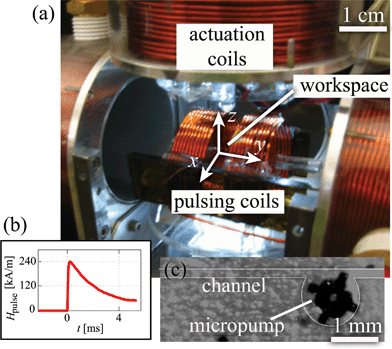 | ||
| Fig. 1 Photograph of the electromagnetic coil system: (a) Actuation and pulsing coils surrounding the workspace; (b) measured Hpulse as a function of time for a 130 V capacitor charge, showing a peak of 240 kA m−1 and duration of several milliseconds; (c) the micropump and channel used in this study. | ||
2.2 Powder composite magnetization disabling
This type of magnetic disabling cannot be achieved with a single magnetic material. The permeability of magnetic materials is very high when the material is far from saturation, making it difficult to demagnetize a sample exactly with a field pulse. While steadily decreasing AC fields can be used to effectively demagnetize a magnetic material, this method does not allow for addressable demagnetization because it will disable all magnets in the workspace. Thus, the use of the magnetic composite enables novel untethered addressable magnetic disabling.
Due to their proximity in the matrix, the magnet grains can potentially interact with each other via exchange coupling, as is the case of exchange spring magnets.19 If this were the case, the ferrite magnetization would be coupled to the NdFeB, preventing it from switching magnetically and increasing the effective coercivity of the ferrite. However, as the coercivity of ferrite is much higher than the remanence of NdFeB, exchange coupling is considered negligible. This is verified experimentally by noting that the effective observed coercivity of the ferrite is not changed when in composite form with NdFeB.
3 Results
The magnetization H-m loop for the micropump is shown in Fig. 2(a), as taken in an alternating gradient force magnetometer (AGFM, Princeton Measurements MicroMag 2900), with applied field strength up to 1110 kA m−1. The plot shows two distinct saturation moments ms of about ms,ferrite = 1.5 μA m2 at 300 kA m−1 and ms,ferrite + ms,NdFeB = 3.3 μA m2 at 800 kA m−1. The moments of the two materials must be equal to cancel exactly when the device is turned off. To allow the fine tuning of this cancellation, the volume ratio of the two materials is chosen so that ms,NdFeB is slightly larger than ms,ferrite. The NdFeB magnetizing field is then adjusted in the AGFM in an iterative fashion to lower mNdFeB from its saturation value such that mNdFeB equals ms,ferrite.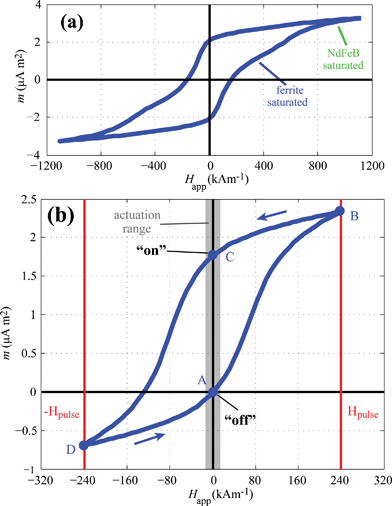 | ||
| Fig. 2 H-m hysteresis loops of the microdevice, taken in an alternating gradient force magnetometer. (a) The microdevice magnetic moment for applied field up to 1110 kA m−1 shows distinct ferrite and NdFeB coercivity and saturation values. (b) A 240 kA m−1 field switches the ferrite magnetization while leaving the NdFeB unaffected, resulting in a vertically-biased loop intersecting the origin. Traversing the hysteresis loop, the device begins in the “off” state at point “A”, where motion actuation fields, indicated by the ± 12 kA m−1 range, only magnetize the device to about 0.08 μA m2, resulting in minimal motion actuation. To turn the device on, a 240 kA m−1 pulse is applied in the positive y-direction, bringing the device to point “B”. After the pulse, the device returns to point “C”, in the on state. Here, motion actuation fields vary the device moment between about 1.7 and 1.8 μA m2. To turn the device off, a negative y-directed pulse is applied, traversing point “D”, and returning to the off state at point “A” at the conclusion of the pulse. | ||
When fields are applied below the NdFeB coercivity, the NdFeB acts as a permanent magnet, biasing the device magnetization, as shown in the H-m loop of Fig. 2(b) for applied field Happ up to ± 240 kA m−1. Traversing the hysteresis loop, the device begins in the “off” state at point “A”, where motion actuation fields, indicated by the ± 12 kA m−1 range, only magnetize the device to about 0.08 μA m2, resulting in minimal motion actuation. To turn the device on, a 240 kA m−1 pulse is applied in the forward direction, bringing the device to point “B”. After the pulse, the device returns to point “C”, in the “on” state. Here, motion actuation fields vary the device moment between about 1.7 and 1.8 μA m2. To turn the device off, a pulse in the backward direction is applied, traversing point “D”, and returning to the “off” state at point “A” at the conclusion of the pulse. For small motion actuation fields in the lateral direction, the device is expected to show even lower permeability in the on or off state due to the shape anisotropy induced during the molding process.
3.1 Micropump alignment
When disabling a device by applying a pulse in the backward direction, the antiparallel alignment of the device with respect to the pulse is critical. Even a minor misalignment will result in in-plane torques which would rotate the device into alignment with the pulsed field before the device is disabled. The torques acting on the device during this process are the applied magnetic torque, frictional drag torque and the fluid drag torque. The applied magnetic torque is | (1) |
 is the device magnetic moment, and
is the device magnetic moment, and  is the applied flux density as a function of time. As the pulse is created by a capacitor bank discharged through a coil (inductor), the applied flux density is governed by the second order series LCR circuit equation20
is the applied flux density as a function of time. As the pulse is created by a capacitor bank discharged through a coil (inductor), the applied flux density is governed by the second order series LCR circuit equation20 | (2) |
The frictional resistive drag torque from contact with the substrate is given as
 | (3) |
 | (4) |
 | (5) |
 is the rotational inertia about the vertical axis and θ is the in-plane rotation angle of the device. An integration of eqn (5) with initial misalignment angle θi for the pulse Hpulse will determine if the device is disabled before it rotates. This result is shown along with experimental results in Fig. 3(c). The simulation predicts the critical angle range for misalignment tolerance to disable to be 180 ± 30°, where θi = 180° denotes the backward (disabling) direction. For larger misalignments (resulting in oblique magnetization), the simulation predictions are erratic due to oscillatory motion. Thus, this regime is not considered in the simulation results.
is the rotational inertia about the vertical axis and θ is the in-plane rotation angle of the device. An integration of eqn (5) with initial misalignment angle θi for the pulse Hpulse will determine if the device is disabled before it rotates. This result is shown along with experimental results in Fig. 3(c). The simulation predicts the critical angle range for misalignment tolerance to disable to be 180 ± 30°, where θi = 180° denotes the backward (disabling) direction. For larger misalignments (resulting in oblique magnetization), the simulation predictions are erratic due to oscillatory motion. Thus, this regime is not considered in the simulation results.
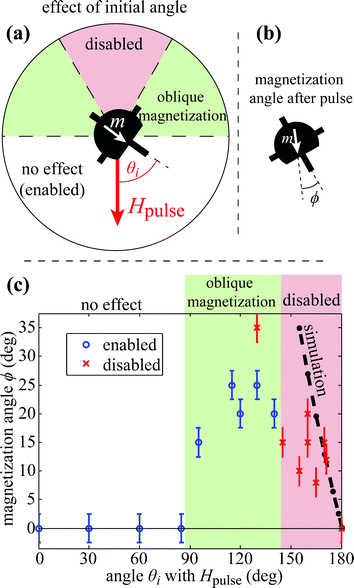 | ||
| Fig. 3 Permissible initial misalignment of the micropump with respect to the pulse. (a) The device forward direction relative to the pulse direction is given by θi. For forward pulses (small θi), no change is observed. For moderate misalignment, the micropump resulting magnetization is obliquely oriented. For reverse pulses, the micropump is disabled. (b) The direction of magnetization after the pulse is given by φ. (c) The resulting magnetization angle is graphed for various initial misalignment angles. To disable the device, it must be pulsed within ± 35° of the backward direction. Disabled devices, which are too weak to spin, still retain a small amount of magnetization in the forward direction. The dotted line shows the simulated values of φ for small misalignments. | ||
The critical angle range for misalignment tolerance to disable was found experimentally to be approximately 180 ± 35°, as shown in Fig. 3. For initial alignments within ±90° of 0° (forward pulses), the device remains magnetized in the forward direction. For moderate misalignments, the device rotates during the pulse and the resulting magnetization is not in the forward direction (and tends to be unpredictable).
As seen in eqn (5), to increase the allowable disabling misalignment, the friction and drag torque can be increased by choice of geometry, material, and fluid properties, the magnetic torque can be decreased by reducing the strength of the magnetic moment m, or the pulse rise time can be shortened to magnetize the device sooner by lowering the circuit time constant τ = LC. A reduced value of τ would necessitate an increase in the charge voltage V0 to maintain the peak Hpulse value.
3.2 Selective micropump actuation
The proposed disabling method for microdevices can be used to selectively disable multiple micropumps. Based on their orientation when the pulse is applied (and independent of position), each micropump will be disabled or remain enabled, as was shown in the previous section. To selectively orient multiple micropumps without experiencing any translational motion before the switching pulse is applied, a four step method is employed, as shown in Fig. 4: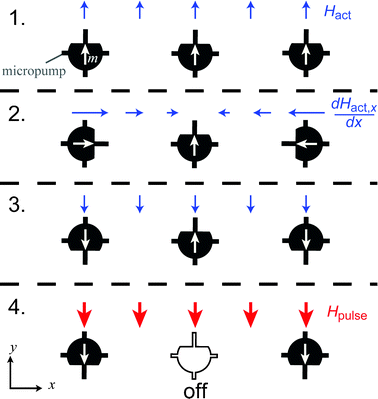 | ||
Fig. 4 Selective micropump orientation method. Using a four step process, a single device is chosen to be disabled. 1. Using a uniform upward field, all devices are pointed in the y-direction. 2. Using two horizontal coils operated in opposition, a horizontal field gradient  is applied. At the center of the coil system, a point of zero field exists, positioned over one of the micropumps. This point can be shifted horizontally to select different devices for disabling. 3. A uniform −y field is applied, rotating all devices down except the selected device, which has zero torque due to being antiparallel to the applied field. 4. The switching pulse Hpulse is applied to switch all devices pointing in the +y-direction. Devices pointing in the −y-direction are unaffected. Fluid channels are not shown for clarity. is applied. At the center of the coil system, a point of zero field exists, positioned over one of the micropumps. This point can be shifted horizontally to select different devices for disabling. 3. A uniform −y field is applied, rotating all devices down except the selected device, which has zero torque due to being antiparallel to the applied field. 4. The switching pulse Hpulse is applied to switch all devices pointing in the +y-direction. Devices pointing in the −y-direction are unaffected. Fluid channels are not shown for clarity. | ||
1. Using a uniform upward field, all devices are oriented to the same direction (+y-direction).
2. Using two horizontal coils operated in opposition, a horizontal field gradient  is applied. At the center of the coil system, a point of zero field exists, positioned over one of the micropumps. This point can be shifted horizontally to select different devices for disabling.
is applied. At the center of the coil system, a point of zero field exists, positioned over one of the micropumps. This point can be shifted horizontally to select different devices for disabling.
3. A uniform field in the −y-direction is applied, rotating all devices except the selected device, which has zero torque due to being antiparallel to the applied field.
4. The field pulse Hpulse is applied to disable all devices pointing in the +y-direction. Devices pointing in the −y-direction are unaffected because their orientation θi = 0° is parallel to Hpulse.
Thus, a large number of microdevices can be independently addressed by magnetic disabling if they are adequately spaced in a single direction. The minimum horizontal spacing smin will depend on the magnitude of the magnetic gradient field created and the minimum torque Tmin required to orient the microdevices in step 2 above. Using (1), this minimum spacing can be derived as
 | (6) |
Multiple pumps can be disabled by repeating the process for each pump to be disabled. Previously disabled pumps will remain oriented in the +y-direction while subsequent pumps are disabled. Selective actuation could be achieved for two-dimensional arrays of microdevices through the concurrent use of x- and y-directed field gradients, but is not shown in this work.
3.3 Micropump switching
A 800 × 800 × 75 μm3 micropump is tested in situ to characterize the magnetic switching behavior. The simple remote motion actuation task used to test the micropump consists of finding the rotation rate of the micropump in the presence of a 5 Hz rotating magnetic field of magnitude 5.0 kA m−1. The rotation rate is observed visually from experimental video taken at 70 Hz. Each “enabling” experiment begins with the device fully off from Hpulse = 240 kA m−1 in the backward direction. Then Hpulse of various strengths is applied in the forward direction to turn on the device. These data points are shown as positive Hpulse values in Fig. 5. Each “disabling” experiment begins with the device fully on, with Hpulse of various strengths applied in the backward direction to turn off the device. These data points are shown as negative Hpulse values in Fig. 5. Motion actuation is taken as the rotation speed of the micropump ωpump, normalized by the rotation speed of the applied field ωfield, showing clear micropump “on” and “off” states. It is seen that the device remains fully on with negative pulses weaker than −70 kA m−1, and becomes fully off with pulses stronger than −210 kA m−1. It is seen that the device begins to enable with positive Hpulse around 60 kA m−1, and becomes fully on at around Hpulse = 90 kA m−1. The sharp change in actuation for a critical Hpulse magnitude is advantageous, and shows that the magnetization of the device need not be completely disabled to prevent the microdevice from rotating at full speed.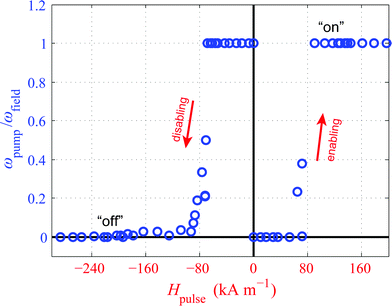 | ||
| Fig. 5 Micropump motion actuation as a function of pulse strength, showing hysteresis behavior. Motion actuation is taken as the rotation speed of the micropump ωpump, normalized by the rotation speed of the applied field ωfield. When being disabled from the on state using negative Hpulse , a fully on state is observed for pulses weaker than −70 kA m−1 and fully off for pulses stronger than −210 kA m−1. When being enabled from the off state using positive Hpulse, a fully off state is observed for pulses less than 60 kA m−1 and fully on for pulses greater than 80 kA m−1. | ||
3.4 Two micropump switching demonstration
Two 800 μm micropumps are placed in polyurethane microchannels similar to those used in conventional microfluidic devices21 as shown schematically in Fig. 6(a). Polyurethane is used in place of the usual polydimethylsiloxane because polyurethane shows lower adhesion with the micropumps. Each micropump is placed offset in the channel to provide the pumping motion as in Agarwal et al.,9 and is constrained to its location by a polyurethane post in the center of the offset region. After placement of the micropumps in their channels, a glass cover slip is bonded to the top of the polyurethane to enclose the channels. Light pressure is applied to ensure a close seal between the polyurethane layer and the glass. The entire assembly is then placed in the electromagnetic coil system for actuation.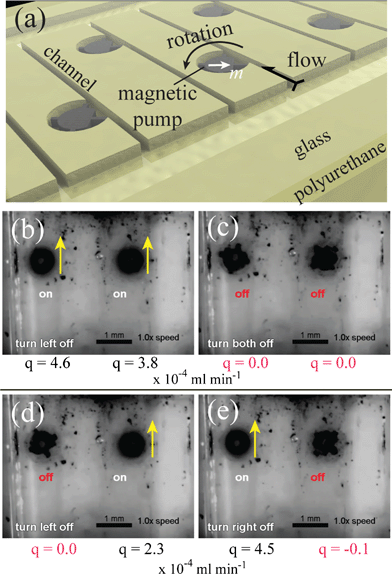 | ||
| Fig. 6 Frames from a video of two addressable micropumps in microfluidic channels. (a) A rendering of the fluid channel for an array of micropumps. Each of the micropumps, actuated by rotating applied field of magnitude 9.0 kA m−1 at a rate of 30 Hz, can be addressed by selective disabling. (b) Both micropumps are on. (c) Both micropumps are off. (d) The left micropump is disabled. (e) The right micropump is disabled. The liquid is 5 cSt silicone oil, and black ink particles are included for flow visualization. Flow direction is indicated by yellow arrow and the approximate flow rate q is given below each channel with an approximate error of ± 0.2 × 10−4 mL min−1. Video showing selective pumping is available in the ESI.† | ||
The flow in each independent channel is visualized by optically tracking small suspended black particles of approximate size 10–50 μm in the 5 cSt silicone oil liquid. The approximate flow rate q is calculated from the fastest particle in each channel by assuming a parabolic velocity distribution in the channel of width 100 μm and height 150 μm. Thus, the mean velocity is taken as approximately half of the maximum velocity,22 averaged over at least 1.0 s. The fabricated micropumps are disabled using the methods presented to show addressing of two devices in Fig. 6(b–e), which represents one continuous experiment, and show that any combination of micropump states are achievable. Pumps in the “off” state are not completely disabled, and vibrate slightly without rotating, resulting in minimal fluid motion. The approximate flow rate is shown below each channel in Fig. 6(b–e), showing distinct “on” and “off” states. In Fig. 6(e), a small negative flow rate is seen because all channels are connected at the ends, resulting in some coupling between the flows. This could be avoided through the use of independent channels for each micropump. Variation in flow rate for the “on” micropumps is due to the gap of about 20 μm between the micropump and the post about which it rotates. This means that the pump-wall spacing may vary between trials, which can affect the rate of pumping. This flow rate variation could be reduced by tightening the gap through more precise fabrication. Limited by the video resolution for particle tracking, the flow rates are found with an approximate error of ±0.2 × 10−4 mL min−1.
3.5 Five microdevice switching demonstration
To demonstrate the capabilities for scalable microdevice addressability using the methods presented, an array of five simple magnetic microactuators are addressed, as shown in Fig. 7. Here, 600 μm arrow shapes rotate about polyurethane posts on a polyurethane surface in silicone oil of viscosity 20 cSt without the added complexity of the microchannels as a proof-of-concept demonstration.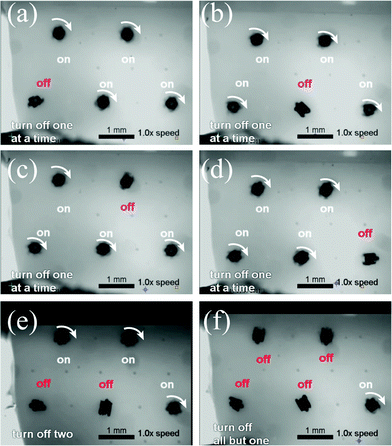 | ||
| Fig. 7 Frames from a video of five addressable microactuators, spinning in place about a polyurethane post by a rotating applied field of magnitude 4.0 kA m−1 at a rate of 30 Hz. Each of the microactuators can be addressed by selective disabling. Rotating actuators are seen as blurry, and are also indicated with rotation arrows. (a–d) One microactuator at a time is turned off. (e) Two microactuators are turned off in sequence. (f) All actuators but one is turned off. Video is available in the ESI.† | ||
It is shown in Fig. 7(a–d) that any device can be disabled while all other devices remain on and in Fig. 7(f) that all devices but one can be turned off. In addition, to turn off more than one device, a multi-step method is used starting with a single disabled pump. This disabled pump now maintains its orientation. Then, the second pump to disable is selectively oriented to align with the already disabled pump. At this point, a pulse turns the second device off. In this way, any desired combination of devices can be turned on or off, as seen in Fig. 7(e).
4 Conclusions
We demonstrated a new micro-scale magnetic composite micropump which can be remotely and repeatedly switched between “on” and “off” states by an externally-generated magnetic field pulse. The switching behavior was found to clearly reduce the motion actuation of the device in the “off” state to nearly zero. Through the use of spatial magnetic field gradients, single or multiple micropumps were selected for disabling, leading to addressable pumping behavior for multiple microdevice applications. The scalability of the concept was demonstrated with a simplified microdevice array. Here, five microdevices were individually addressed in any combination.Although the devices shown are around 800 μm in size, the device is expected to scale smaller without change in performance as long as the magnetic properties are maintained. High viscosity liquid was used in this study to allow for easier disabling, but liquid such as water could be used if the charge voltage of the pulsing circuit is increased to several thousand volts and the capacitance reduced, allowing a faster pulse rise time with the same Hpulse peak value. The addressable magnetic composite microdevice concept can be extended to other micro-scale systems using magnetic actuation, and the composite material can be simply molded into any desired shape. Future works will include the use of this switching device as an addressable actuation method for microfluidic valves, mobile microrobots, and other magnetic microelectromechanical devices.
References
- K. S. Ryu, K. Shaikh, E. Goluch, Z. Fan and C. Liu, Lab Chip, 2004, 4, 608–13 RSC.
- K. Ishiyama, M. Sendoh, A. Yamazaki and K. Arai, Sens. Actuators, A, 2001, 91, 141–144 CrossRef.
- T. Honda, K. Arai and K. Ishiyama, IEEE Trans. Magn., 1996, 32, 5085–5087 CrossRef.
- D. R. Frutiger, K. Vollmers, B. E. Kratochvil and B. J. Nelson, Int. J. Rob. Res., 2009, 29, 613–636 CrossRef.
- S. Floyd, C. Pawashe and M. Sitti, Int. J. Rob. Res., 2009, 28, 1077–1094 CrossRef.
- M. Sitti, Nature, 2009, 458, 1121–1122 CrossRef CAS.
- J. Judy, Sens. Actuators, A, 1996, 53, 392–397 CrossRef.
- T. Sawetzki, S. Rahmouni, C. Bechinger and D.W. M. Marr, Proc. Natl. Acad. Sci. U. S. A., 2008, 105, 20141–5 CrossRef CAS.
- A. Agarwal, S. Sridharamurthy and D. Beebe, J. Microelectromech. Syst., 2005, 14, 1409–1421 CrossRef.
- S. Floyd, E. Diller, C. Pawashe and M. Sitti, Int. J. Rob. Res., 2011, 30, 1553–1565 CrossRef.
- B. Donald, C. Levey and I. Paprotny, J. Microelectromech. Syst., 2008, 17, 789–808 CrossRef.
- C. Pawashe, S. Floyd and M. Sitti, Appl. Phys. Lett., 2009, 94, 164108 CrossRef.
- P. Braillon, patent, 4075589, 1978 Search PubMed.
- K. Gilpin, A. Knaian and D. Rus, IEEE Int. Conf. Rob. Autom., 2010, 2485–2492 CrossRef.
- D. J. Laser and J. G. Santiago, J. Micromech. Microeng., 2004, 14, R35–R64 CrossRef.
- E. Diller, C. Pawashe, S. Floyd and M. Sitti, Int. J. Rob. Res., 2011, 30, 1667–1680 CrossRef.
- M. Imbaby, K. Jiang and I. Chang, J. Micromech. Microeng., 2008, 18, 115018 CrossRef.
- J. Kim, S. E. Chung, S. Choi, H. Lee, J. Kim and S. Kwon, Nat. Mater., 2011, 747–752 CrossRef.
- E. Fullerton, J. Magn. Magn. Mater., 1999, 200, 392–404 CrossRef CAS.
- J. Nilssonand S. Riedel, Electric Circuits, Prentice Hall, 8th edn, 2010 Search PubMed.
- G. M. Whitesides and A. D. Stroock, Phys. Today, 2001, 54, 42 CrossRef CAS.
- S. Turns, Thermal-Fluid Sciences: An Integrated Approach, Cambridge University Press,Cambridge, 2006 Search PubMed.
Footnote |
| † Electronic Supplementary Information (ESI) available: Videos of selective disabling of two micropumps and five microdevices are given. See DOI: 10.1039/c2ra01318e/ |
| This journal is © The Royal Society of Chemistry 2012 |

